Title: | Macnamara Myths [relating to John Macnamara of Llangoed Hall] |
Date: | 1790s – 1840s |
Guest contribution by Miriam Griffiths
Introduction:
The article below is a biographical sketch of John Macnamara who with his wife Mary owned Llangoed Hall, an estate between Hay and Brecon which included land in the Black Mountains. In correcting a number of apocryphal stories about John Macnamara (died 1818) and his property, the author sets out her research into the history of The Hermitage in the Grwyne Fechan valley and construction of the road leading to it.
The article appeared in the ‘The Beacon’ published by the Brecon Beacons Park Society, Summer 2008 issue, and is reproduced here with the author’s permission.
Ewyas Lacy Study Group
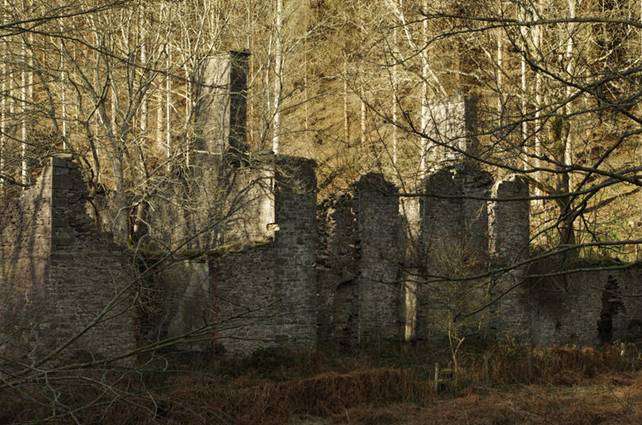
Ruins of The Hermitage
MACNAMARA MYTHS
By Miriam Griffiths
The name Macnamara is known to walkers in the Black Mountains for two reasons: the John Macnamara legends and stories, of shadowy origin and doubtful credibility; and several ‘Mrs. Macnamara’ boundary stones of shaped local sandstone on some Black Mountains ridges. During research inspired by my curiosity about Mrs. Mary Macnamara, I have come across information which throws a little light on some of the John Macnamara legends. This article sets out to do a bit of myth-busting; there will be a piece on Mary Macnamara’s boundary stones in the next Beacon.
Between 1796 and 1847 the Macnamaras owned about 54000 acres of land, known as the Llangoed Estate, in Breconshire. John Macnamara died in 1818 aged 63, after which the estate was jointly managed by his widow Mary and their oldest son Arthur. Mary died in 1835, after which Arthur Macnamara had sole control. In 1847 Arthur sold the estate (to Sir Joseph Bailey, who became the first Lord Glanusk) and the Macnamara family left the area. The northern boundary of the Llangoed estate ran approximately between Gwenddwr in the north west and near Hay in the north east. The estate stretched south through Llyswen, where the Macnamaras’ residence, Llangoed Hall - then called Llangoed Castle, now a hotel - was situated by the river Wye and on southwards into the Black Mountains, taking in the upper valleys of the Grwyne Fechan and Grwyne Fawr. In the Black Mountains, the estate’s most easterly border ran along part of the Y Fan ridge (south from Pen Rhos Dirion) and its most westerly point was the col at Cockitt hill.
The Purchase of the Llangoed estate
The story of the Macnamaras’ purchase of the Llangoed estate from Sir Edward Williams in 1796 is told in Rob Adams’ 2003 article, ‘Fishing in Troubled Waters’, in the journal Brycheiniog.[1] John and Mary (née Jones) had married in 1780 and had four children by the time they decided to purchase the estate in 1796; there was mention that Mary’s distant ancestors had once owned the land. The popular story that Macnamara won the Llangoed estate through gambling or in a card game is thoroughly disproved in Rob Adams’ article, which gives glimpses of possible reasons why this type of legend grew up about him. Parts of the estate were subject to complex, lengthy legal disputes, which Macnamara fought with great gusto. Because of these disputes, the Macnamaras had to lease parts of the estate from Sir Edward pending the legalities of transferring ownership, resulting in various complex financial transactions. Macnamara was also involved in other legal cases — for example, to gain access to Mary Macnamara’s father’s estate after his death, which apparently did not pass smoothly to his daughter (his only child) and son-in-law.
John Macnamara’s letters and other sources attest to his noisy rumbustious and quarrelsome character[2] , as Rob Adams comments (p78).
Judging by his correspondence, Macnamara was something of a ‘character’ with strong views. He also had a fairly colourful past. By his own admission he had spent the early part of his life “whoring, drinking, gambling, duelling etc etc”. In Macnamara’s parliamentary days we hear of him twice being involved in altercations with mobs.
Letters of John Macnamara’s that I have read certainly give a glimpse of a forceful and expressive personality: for example, he states in a letter of 1797 that anyone opposing his purchase of disputed parts of the Llangoed estate “shall find a very powerful opponent in me, I promise you!”, while he expresses his reaction to a family problem (the elopement from Llangoed Castle of their daughter with their sons’ Tutor at Christmas 1799) as having “..fallen from a summit of human felicity to the lowest abyss of misery."[3]
Llangoed Hall stands on the site of Llangoed Castle 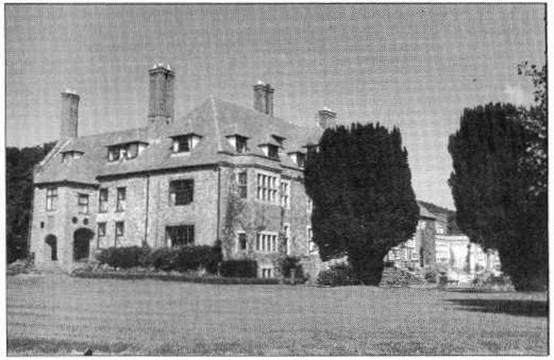
This kind of personality, with a tendency to melodramatic turn of phrase and a taste for litigation, attracts gossip which may be exaggerated into scandal-mongering, or into fictions which may be entertaining but which do not reflect the real history and biography which have shaped our landscapes.
I came across a good example of misinformation about the Macnamaras in the Powys County Records Office.[4] In the 1950s the headmaster of Builth Wells Primary School, one Onfel Thomas, sent to Mrs Christy then occupier of Llangoed Hall, some typed papers about the Macnamaras. One of these has John Macnamara coming to Brecon as a single man, making the Castle Hotel "his headquarters”, throwing (borrowed) money about and seeking out wealthy residents then targeting his "unfortunate victim.., the daughter and the only child of Sir Edward Williams of Llangoed Hall” whom he quickly married for her land and money. However, Onfel Thomas claims, due to financial difficulties the couple had to mortgage the estate to “one of the Baileys”.
We can see the possible seeds of truth behind this outrageous fiction about the Macnamaras: an old family link was possible between Mary and the Llangoed estate, but she was certainly not the daughter of the vendor, Sir Edward Williams. John did not marry Mary for her estate — they had married 16 years earlier; and the estate was not “mortgaged” to Joseph Bailey but was eventually sold to him in 1847 by Arthur Macnamara. Perhaps John Macnamara did stay in Brecon and behave flamboyantly— Rob Adams mentions that the Macnamaras’ arrival in the area caused quite a stir (p76). Perhaps the complex legal and leasing arrangements and then the eventual sale to Bailey became transmuted and tangled into the mortgage story. Whether Onfel Thomas was, simply repeating local tales or spinning them with extra exaggeration of his own, we shall probably never know; I shall return to his yams later.
Macnamara’s Road and the Hermitage
Local anecdotes about John Macnamara may have given rise to the story that he kept a mistress at the Hermitage, a secluded and remote house in the Grwyne Fechan valley, and that he had a carriage road built in order to access the Hermitage; I have so far found no evidence in favour of these stories. John Macnamara was not much interested in his Welsh estate; several of his letters refer to the fact that he is in England while his wife and family are in Wales and it is perhaps improbable that a man would install a mistress on the inaccessible outer fringes of his less-favourite estate.
‘Macnamaras Road’ leading down into the Grwyne Fechan Valley
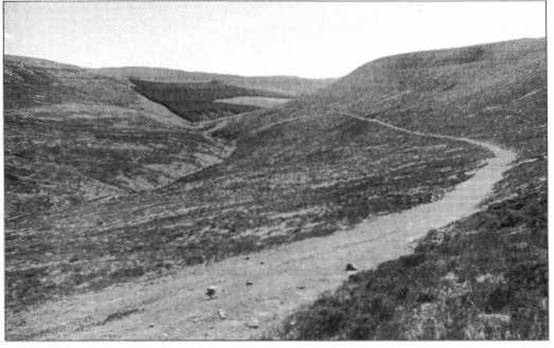
‘Macnamara’s Road’ is said to rise eastwards from the upper Rhiangoll valley, cross over the Pen Trumau col on the ridge north of Pen Allt Mawr and drop down south- eastwards to the Grwyne Fechan. This story is mentioned, without attribution to source, in several guides to the area and has also been written about in The Beacon. Peter Morgan Jones, in his recent book Beyond the March Wall[5] , cites evidence that this was an ancient established route but he finds no evidence in early Ordnance Survey maps that it was more than a horse track or bridleway in the eighteenth and nineteenth centuries. I turned to the Tithe map of 1841[6] - made more than twenty years after John Macnamara’s death but still within the period when the Llangoed estate was in Macnamara family ownership - which does show a road (not a road as we would know it, of course) approaching the Hermitage from the south along the valley bottom, but which certainly does not indicate a road or track capable of taking a wheeled vehicle along the upland route north of the Hermitage. I also inspected the Macnamara’s Road track itself: on the section that descends from the col into the upper Grwyne Fechan valley, there is evidence of basic stone support engineering. If forced to speculate, I would guess this work perhaps dated from the same era as the building of Tal y Maes bridge across the Grwyne Fechan river and that it might possibly have had something to do with accessing the hill for quarrying or other land use.
Another revealing source of information is Theophilus Jones’s A History of the County of Brecknockshire, originally published in two volumes in 1805 and 1809. The more commonly available version is the one published in three volumes in 1909 and 1911, which had considerable alterations and additions made to the original by Sir Joseph Russell Bailey, Lord Glanusk. The original edition only mentions the upper Grwyne Fawr and the Grwyne Fechan very briefly in passing; specific sections on the Grwyne Fawr and Grwyne Fechan were newly written for the later edition. In the 1911 volume[7] , in the section on Grwyne Fechan we find:
"The bottom of the valley is cultivated for about half its length, and for that distance has a good road made by the late Mr. Macnamara, as an approach to the Hermitage, built for a gentleman’s residence, but too remote for the purpose. From the Hermitage northward to Cwmdu and Talgarth, there is a bridle path passing for four miles over a mountain pass."
It is clear from this description written in the first decade of the twentieth century that the road “made by the late Mr Macnamara” approached the Hermitage from the south, that is from lower down, the bottom part of the Grwyne Fechan valley (as shown in the 1841 Tithe map), while the route northwards up over the col on the ridge was simply a “bridle path”. Could a careless reading of this passage have given rise to the Macnamara’s Road story?
Ruins of ‘The Hermitage’ 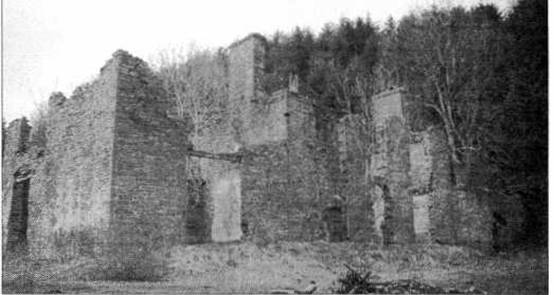
Given the date when that passage was written (early 1900’s) there is a likelihood that the “late Mr. Macnamara” referred to as having made a good road south of the Hermitage was Arthur Macnamara, John and Mary’s son, rather than John himself. Possible evidence to support this is in a dusty and as yet uncatalogued collection of papers at the National Library of Wales[8] containing documents relating to Mary’s and Arthur’s management of the Llangoed estate after John Macnamara’s death. While my main interest in these papers is in connection with Mary, they do contain a few clues about the Hermitage. I do not know when the Hermitage was built. Peter Morgan Jones uses evidence from early OS maps to show that a building first appeared at the site between 1803 and 1832 and guesses that it was John Macnamara who built it before his death in 1818. These papers show that Arthur spent considerable money on the Hermitage during the 1830s and 1840s - he had a new extension built and substantial improvements made: the fruits of his expenditure may perhaps be visible in the photo in the 1913 book by R. Baker-Gabb The Hills and Vales of the Black Mountains District (p55). It is possible that the road accessing the Hermitage from the south was made, or greatly improved, during the period when Arthur was busy improving and maintaining the Hermitage — the 1830s and 1840s.
Picture of the Hermitage in ‘The Hills and Vales of the Black Mountains District’ by R. Baker-Gabb 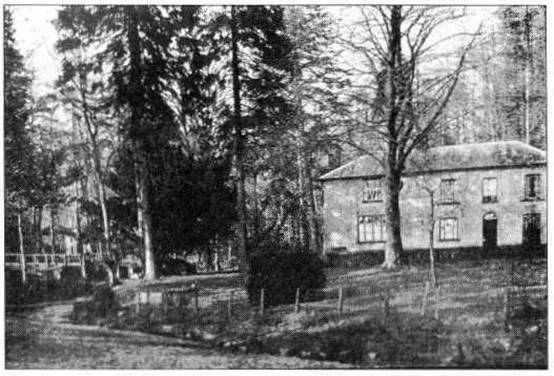
Last wishes — John Macnamara’s grave.
Among the papers of Onfel Thomas there is a typed English translation from Hanes yr Eglwysi Annibynnol (‘History of the Independent Churches’) relating to the chapel on Brechfa Common (north-east of Brecon) which was part of the Llangoed estate. This document, which has some muddled dates and facts, contains another, less well-known Macnamara tale. A non-conformist chapel had apparently been built in 1791 at Brechfa but Macnamara is said to have appropriated it and made it into dwellings.
It is reported that Macnamara felt very unhappy sometime after taking possession of the Chapel, and to ease his conscience, as well as silence the curses heaped upon him by the whole neighbourhood, he sent £20 towards the building of the New Chapel.
Given his inaccuracies, I would take anything written by Onfel Thomas with an enormous grain of salt — but this is an interesting anecdote because it reflects some very real historical aspects. Perhaps some of the tales about Macnamara were fuelled by animosity felt by local nonconformist chapel-goers towards wealthy, establishment, in-comer landowners like him, whose local power was tied up with strong Anglican parish influence from a time when the parish was a unit of local government. This is speculation on my part.
In this account of Brechfa chapel there is also a version of another Macnamara story — that of his grave. It says that Macnamara was a “strange creature” who had his favourite horse and dog buried in a “costly vault” in the park of his “palace” and that:
”on his deathbed he gave a strict injunction to bury him with his horse and dog, and so it was done. Of the three that was (sic) buried in the grave, the man deserved the least honour...”
John Macnamara was indeed buried in the grounds of Llangoed Castle, on a mound by the river, with a tomb atop. The inaccurate notion that the Llangoed estate was “mortgaged” is carried through into the following, written down by the headmaster over half a century ago:
"Macnamara got the clause inserted into the deed of mortgage that the estate was not to be touched as long as he was on the surface of the ground On his deathbed his command was that his favourite horse and dog together with his own body should be placed on the surface of the ground and earth thrown over them, so that he may still be on the surface to keep the estate untouched by the mortgagee."
Rob Adams does explain that the leases enabling the Macnamaras to occupy parts of the estate pending legal clarification of ownership rights did have some lifetime terms attached to them: perhaps this is one seed of this story. John Macnamara’s own words do not support it. He died in May 1818; his will[9] which had been drawn up in 1817 and was proved in July 1818, opens with these words:
"This is the last will and testament of John Macnamara of Llangoed Castle in the county of Brecon esquire. I wish to be buried in the parish church of Llyswen in this county in a plain direct manner at the discretion of my executors hereinafter named."
John could of course have changed his mind after drawing up the will; or perhaps his executors (wife Mary and oldest son Arthur) decided to disregard this wish. John Macnamara’s burial at Llangoed Castle is recorded in Llyswen Parish Register, as is the burial of Arthur Macnamara’s first child Anne Emily who died aged two in 1826. (Mary, who died in 1835, was not buried in the Llangoed plot where there are two other graves, those of the Butlers, later occupiers of Llangoed Hall.) Theophilus Jones’ History of the County of Brecknockshire mentions that, “In the park of Llangoed Castle formerly stood a church”...as well as noting the private burial ground; this may possibly indicate that the plot had been consecrated.
John Macnamara’s grave in the grounds of Llangoed Hall 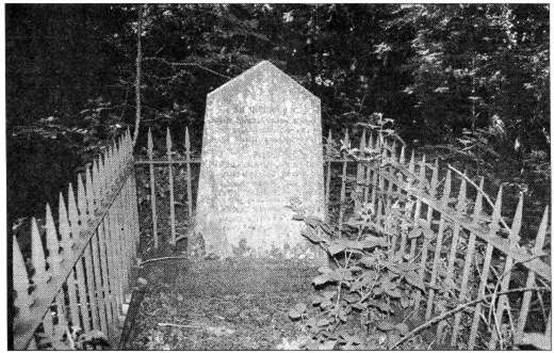
Tal y Maes Bridge on ‘Macnamara’s Road’ 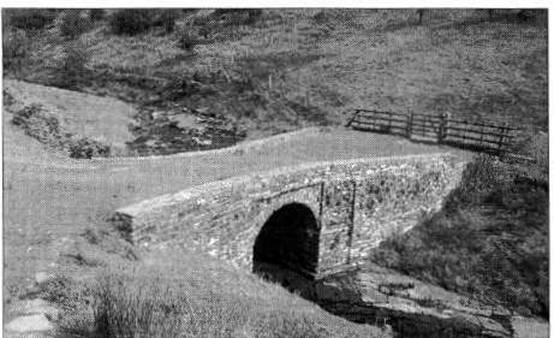
I tend to think of John Macnamara as a ‘larger than life’ character around whom stories, perhaps originally rooted in real events, were spun, repeated, exaggerated, until they became local myths: these are entertaining but reduce the real man to a fictitious stereotype and give us few insights into real local history. Whatever his persona, apparently he was a large man: among Mary Macnamara’s papers is a receipt for his funeral expenses, which included “An extra large and strong wooden shell for leaden coffin”. But then again, perhaps the large coffin was just for effect, in keeping with his reputation?
[1] Brycheiniog: journal of Brecknock Society and Museum Friends.
‘Fishing in Troubled Waters’ is in Volume XXXV, page 71 2003.
[2] Gwernyfed papers, National Library of Wales
[3] Gwernyfed 63
[4] BE/SS/2/HI/4 Powys Records Office
[5] Beyond the March Wall, self-published book about the Black Mountains,
2006. My references are to pages 65-67.
[6] Consulted at Brecon public library
[7] Volume 3 pp110-111
[8] Pennington papers, National Library of Wales
[9] Public Record Office: Prob 11/1606
Ref: nw_lty_1001
